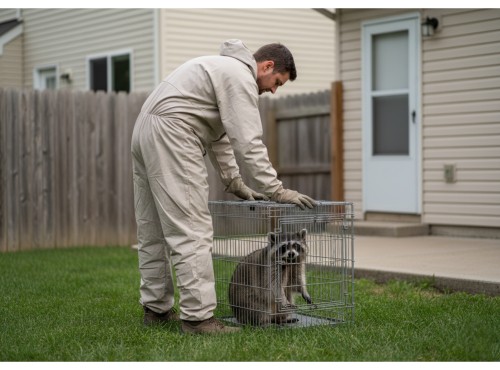
Urban wildlife has become an increasingly common challenge throughout Toronto’s eastern communities. The mix of mature neighborhoods, tree canopies, and nearby ravines provides ideal conditions for various animals to coexist with residents. Although this natural connection is part of the city’s charm, it also brings unique maintenance concerns when creatures find their way into attics, chimneys, or crawl spaces.
These intrusions can cause significant sanitation and structural problems if not handled correctly. Humane wildlife management, carried out by licensed specialists, offers the safest and most responsible method for addressing these conflicts while preserving ecological balance.
Behavior and Adaptation of Toronto’s Urban Wildlife
Raccoons (Procyon lotor) are among the most adaptable mammals in North America. They thrive in urban environments such as Scarborough, Etobicoke, and North York, where access to food and shelter is abundant. Their dexterous forepaws and problem-solving abilities allow them to manipulate vents, shingles, and soffit gaps to access buildings.
According to the City of Toronto’s Wildlife and Forestry Division, populations remain stable despite habitat loss, largely because these animals have substituted attics and sheds for hollow trees.
Habitat and Nesting Patterns
In neighborhoods near Highland Creek, Kingston Road, and the Scarborough Bluffs, raccoons frequently establish dens along rooftops or inside soffits. Their climbing skill enables them to scale walls, fences, and trees with ease. Once they’ve located a suitable entry point, they can quickly tear through aging vents or fascia boards.
Feeding and Foraging Habits
These nocturnal foragers are opportunistic eaters, commonly raiding household waste, compost bins, or outdoor pet food. This pattern is especially noticeable in communities along Brimley Road and Eglinton Avenue East. Limiting access to food sources is a key aspect of Integrated Pest Management (IPM). Property owners can reduce attraction by securing bins, cleaning outdoor eating areas, and removing clutter around structures.
Seasonal Activity and Reproduction
Denning season typically begins in late winter, with females giving birth to litters of two to five kits by spring. Technicians use thermal imaging and ventral inspection tools to locate nests before implementing exclusion, ensuring young animals are not separated from their mothers. Humane timing and proper technique are vital for ethical wildlife control.
Behavioral Science in Humane Animal Management
Understanding wildlife behavior is central to effective control. Studies from the University of Toronto’s Department of Ecology reveal that raccoons can remember problem-solving strategies for years. This intelligence demands durable exclusion work that resists tampering. Technicians use reinforced 16-gauge mesh, metal flashing, and secure fasteners to block entry points.
These animals are also territorial. Their droppings and urine serve as scent markers that can attract others. Cleaning and sanitizing these areas with enzyme-based neutralizers and HEPA-filter vacuuming removes pheromone cues and pathogens such as Baylisascaris procyonis (roundworm) and Leptospira spp., both recognized by Health Canada as potential health risks.
Why Wildlife Thrives in Toronto’s East End
Scarborough’s landscape, a mix of residential zones, wooded ravines, and natural corridors, creates ideal conditions for urban mammals. Routes connecting Rouge National Urban Park, Guildwood Village, and Morningside Park allow easy movement between green spaces and homes.
These animals often travel along Kingston Road and Eglinton Avenue, where restaurant dumpsters and compost bins provide a steady food supply. Recognizing these behavioral corridors helps specialists implement focused exclusion programs and promote community-level prevention strategies.
Professional Inspection and Ethical Exclusion Practices
A detailed site inspection is always the first step toward resolution. A licensed Pest Management Professional (PMP) identifies entry points, nesting zones, and contamination using ladders, infrared cameras, and moisture readings.
Every stage of service complies with the Ministry of Natural Resources and Forestry (MNRF) and Health Canada PCP guidelines. Common methods include:
| Method | Purpose | Typical Use |
| One-way exit systems | Enable animals to leave without returning. | Attics, vents, and soffits. |
| Live capture (limited) | Applied only when exclusion is impractical. | Must follow relocation distance rules. |
| Structural repair | Strengthens vulnerable areas. | Uses steel mesh, flashing, and vent guards. |
| Sanitation and odor control | Removes waste and neutralizes contaminants. | Prevents new infestations and improves hygiene. |
After exclusion, technicians apply microencapsulated or enzyme-based disinfectants approved by Health Canada. These formulations are non-toxic to pets and safe for indoor air quality. The process restores structural integrity while protecting occupants’ health.
Health and Safety Protocols
Wildlife remediation involves strict safety standards for both technicians and residents. Professionals wear personal protective equipment (PPE), including respirators and gloves, to prevent exposure to allergens, dust, and biological waste. Each treatment follows Restricted Entry Interval (REI) and WHMIS procedures for controlled re-entry after decontamination.
Equipment such as HEPA vacuums, foggers, and B&G sprayers are regularly maintained and logged in service records. Sanitation agents used in cleaning and deodorizing have verified PCP registration numbers, ensuring traceability and compliance with federal regulations.
Public Health Considerations
Wildlife droppings can harbor harmful pathogens, including Baylisascaris procyonis (roundworm) and Leptospira spp.. Improper cleanup can aerosolize spores and bacteria, leading to respiratory irritation or illness.
To mitigate risks, technicians use cold fogging or thermal disinfection to sterilize contaminated insulation. This method kills microorganisms and eliminates scent trails that could draw other animals. Following cleanup, contaminated waste is bagged and disposed of in line with Ontario Hazardous Waste Regulations.
Humane and Ethical Handling Standards
Every stage of service, from inspection to exclusion, is guided by humane practices established by the National Pest Management Association (NPMA) and Canadian Pest Management Association (CPMA).
Live capture is only performed when exclusion cannot be safely executed. Animals are relocated according to provincial limits to minimize stress. Before sealing any openings, technicians confirm through thermal imaging that all wildlife has vacated the structure.
This balance of ethics and effectiveness distinguishes professional wildlife management from do-it-yourself approaches. It ensures both property protection and respect for the region’s biodiversity.
Post-Service Cleanup and Monitoring
Once exclusion and cleanup are complete, homeowners receive a detailed report outlining all materials used, treatment products, and safety notes. Areas affected by waste or nesting are vacuumed, sanitized, and dried to prevent mold growth and secondary insect infestations.
A follow-up inspection typically occurs within one to two weeks. This confirms the success of the exclusion work and ensures no new activity has occurred. Many service providers also offer extended warranties covering re-entry within a defined period.
Environmental Stewardship and Community Awareness
Humane wildlife management also supports environmental sustainability. Service providers in Toronto’s east end increasingly rely on biorational and botanical cleaning agents that minimize chemical runoff into nearby waterways such as Highland Creek and Bluffer’s Park.
By prioritizing compliance and ecological responsibility, pest control professionals not only protect homes but also contribute to maintaining the health of the region’s connected ecosystems.
Field Insights: Local Case Summaries
Danforth & Victoria Park:
A homeowner reported persistent attic disturbances. Inspection revealed two access points near the soffit. One-way exit devices were installed, followed by insulation replacement and disinfection.
Outcome: Complete resolution within one week; no recurrence after 12 months.
Lawrence Avenue East Corridor:
Noise from above a warehouse ceiling indicated nesting activity. The technician implemented a Zone Isolation Protocol and sealed roof vents with galvanized barriers.
Outcome: Full clearance verified after 30 days; preventive program initiated.
Scarborough Bluffs District:
A repeat intrusion traced to incomplete prior work was corrected using heavy-gauge mesh and odor-neutralizing spray.
Outcome: Problem solved within two days; follow-up inspection confirmed success.
Pricing Expectations for Humane Services
Costs vary with building size, accessibility, and infestation level. Homeowners across the eastern suburbs typically invest between CAD $350 – $900 for complete inspection, removal, and sealing.
| Service | Typical Cost (CAD) | Details |
| Initial inspection | Around $85 (waived by many firms) | Full site assessment and estimate. |
| Exclusion with one-way system | $275 – $500 | Installation and sealing of main entry point. |
| Structural repair | $300 – $600 | Multi-entry reinforcement and patching. |
| Large/commercial projects | $1,000 – $2,100 | Complex structures or multiple infestations. |
Reputable companies provide written warranties and proof of insurance coverage under the Structural Pest Control Act.
Frequently Asked Questions
- Why is wildlife activity so pronounced in this region?
Green corridors, mature trees, and easy food access create ideal conditions. Warmer winters and unsecured waste further contribute to steady population levels. - How can property owners detect hidden infestations?
Listen for movement at night, inspect vents for damage, and check attics for droppings or torn insulation. Professionals use infrared devices for confirmation. - What is the most humane method of control?
Ethical exclusion using one-way devices remains the preferred strategy. It allows animals to exit safely without re-entry. - Are there health concerns associated with wildlife intrusion?
Yes. Animal waste can transmit parasites and bacteria. Professional cleaning and disinfecting remove these hazards effectively. - How long does the removal process take?
Typical residential cases conclude within two to three business days, followed by a brief monitoring period to verify success. - How can future incidents be prevented?
Regular maintenance, such as trimming trees near roofs, sealing small openings, and storing waste properly, reduces risk significantly.
Preventive Maintenance Through Integrated Pest Management
Sustainable control relies on prevention rather than reaction. Integrated Pest Management (IPM) programs emphasize long-term exclusion, sanitation, and homeowner education. Properties near Guild Park, Bluffer’s Park, and East Point Park benefit from quarterly inspections to identify new vulnerabilities.
Technicians may install chimney caps, vent guards, or foundation screens to reinforce structures. Routine communication between residents and professionals ensures that prevention strategies evolve alongside local wildlife behavior.
Selecting a Qualified Service Provider
When choosing a company, verify:
- A valid Structural Applicator License.
- Up-to-date WSIB and liability insurance.
- Compliance with Health Canada PCP and WHMIS standards.
- Humane-certified and IPM-trained technicians.
GTA Toronto Pest Control provides comprehensive wildlife management across Toronto and nearby communities. The firm’s approach integrates behavioral science, humane exclusion techniques, and ongoing prevention to deliver lasting results for both residential and commercial clients.
Effective raccoon removal demands a balance of behavioral insight, technical expertise, and ethical practice. By understanding how local wildlife interacts with urban spaces, professionals can resolve infestations humanely while preserving environmental harmony.
Residents who partner with licensed experts gain not only immediate relief but also long-term protection for their homes and neighborhoods. For prompt, responsible service, contact GTA Toronto Pest Control.
Author Bio: Naeem Choudhry
Pest Control Expert
Naeem Choudhry is a seasoned pest control specialist with over 20 years of hands-on experience. Based in Toronto, he stays up to date with the latest industry best practices and is an active member of the National Pest Management Association of Canada.
Known for his practical tips and outstanding customer service, Naeem frequently hosts community workshops where he educates the public on pest identification, behaviour, and effective control methods. When he’s not out in the field, he shares his expertise through articles, educational events, and community outreach initiatives.
For more insights, follow him on x.com.
